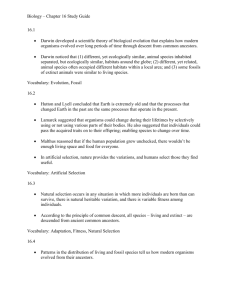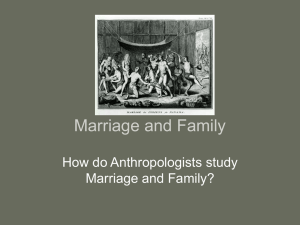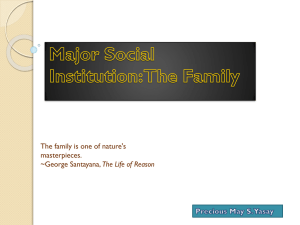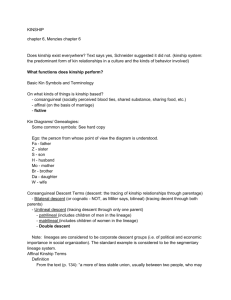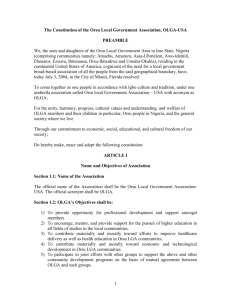Ethnographic Project
advertisement
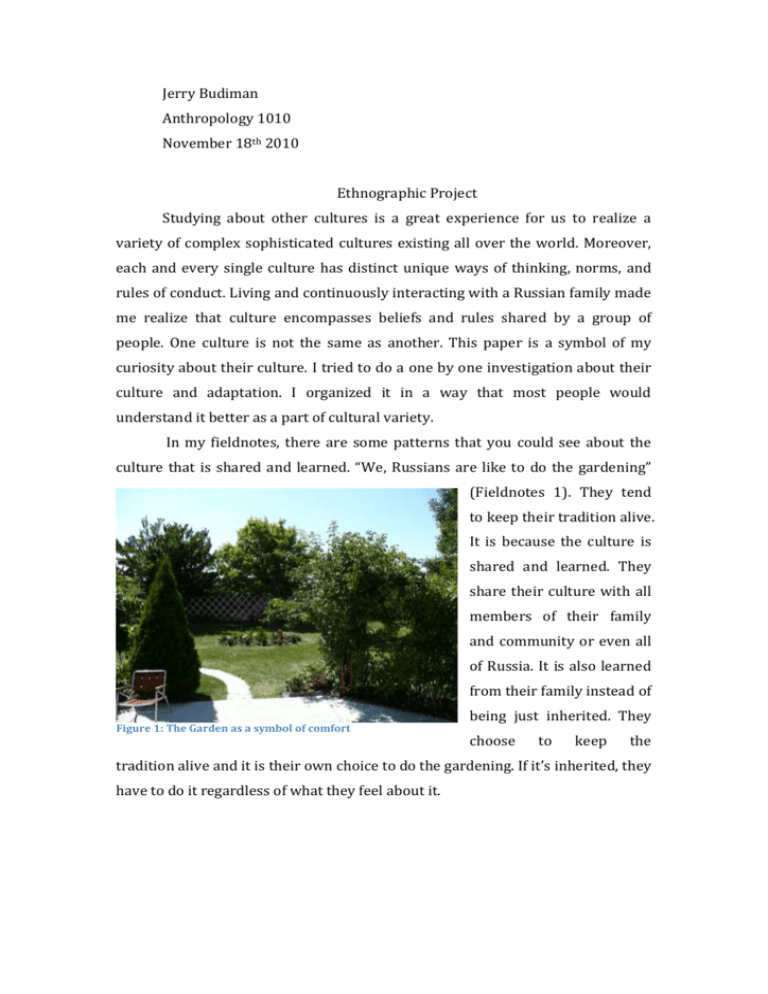
Jerry Budiman Anthropology 1010 November 18th 2010 Ethnographic Project Studying about other cultures is a great experience for us to realize a variety of complex sophisticated cultures existing all over the world. Moreover, each and every single culture has distinct unique ways of thinking, norms, and rules of conduct. Living and continuously interacting with a Russian family made me realize that culture encompasses beliefs and rules shared by a group of people. One culture is not the same as another. This paper is a symbol of my curiosity about their culture. I tried to do a one by one investigation about their culture and adaptation. I organized it in a way that most people would understand it better as a part of cultural variety. In my fieldnotes, there are some patterns that you could see about the culture that is shared and learned. “We, Russians are like to do the gardening” (Fieldnotes 1). They tend to keep their tradition alive. It is because the culture is shared and learned. They share their culture with all members of their family and community or even all of Russia. It is also learned from their family instead of Figure 1: The Garden as a symbol of comfort being just inherited. They choose to keep the tradition alive and it is their own choice to do the gardening. If it’s inherited, they have to do it regardless of what they feel about it. As you can see in the picture above, the garden looks really nice. This garden is one of their symbols in their house that represent the comfort in their house. They believe that a great garden is a symbol that your house is comfortable and beautiful. This is also part of the culture based on symbols. Clearly, a garden is an important symbol for Russian culture as it represents the beauty and elegance of one’s house The values, beliefs, and norms are significant parts of a culture. It is also a part of this family. After preparing and conducting interviews with Russians, I realized that most of the Russians are Christian. They have their own community and special church. They meet at the church every Sunday as their gratitude to God. They pray and sing together as a gift to God. They Figure 2: The writing behind it means Believe have a strong faith in God and think that God is the source of all happiness. Olga, one of my interviewees said, “He always helps us to solve our problem.” This belief among the Russians affects Olga (the person that I asked to interview) to think the same as all of the Russians. Another characteristic of Russians is family oriented. They like to gather and share some stories. I also realized that Olga is not a technology addict. She said that technology brings a lot of problems in this world. Most of the people lost Figure 3: Family Dinner (Russians are family oriented) their job because of the technology. Nowadays, you only need one person to operate a machine instead of using 10 people to do it manually. This is why she is avoiding the technology except computer and TV. For Olga, the computer is one of her work tools because “now, you have to use computer to do everything”(Olga). It has been 19 years since she came to the United States. In order to survive in her new society, a lot of adaptations should be made in addition to the computer adaptation. Olga told me her story about when she first came to United States. She couldn’t eat any American food. For her, the fast food tasted really weird. She didn’t like fast food; she tried to eat at home every time instead of eating out every Saturday or Sunday. Now, everything has changed. She is getting used to fast food. I got a chance to eat her Russian food. In my opinion, the tastes of her foods are not fully Russian anymore. They have a slight taste of American food. The most difficult adaptation Olga made was learning how to operate high-tech equipment. When she first came to United States in 1991, she didn’t know how to operate a computer. She was an accountant, and in order to get a job in her field, she had to study about computers. It was not easy for her to adapt Figure 4: Whole Family and learn about the computer. She was also surprised about the washing machine and the dryer. In Russia, she had to wash her clothes with her hands and dry them using sunlight. These patterns show me that the standard of living in Russia was not as good as the United States. The effort that she made to adapt in her surrounding was a part of transformation in her life. Her culture is not static; it is adapting to her surroundings. This is why one of the characteristics of culture is adaptive. “People must adapt to their environment and culture is their chief mechanism of adaptation. Because of their capacity of adaptation, humans can survive in nearly any environment” (Bonvillain 26). The next thing that I wanted to ask them was about the kinship system. I was having a great idea about this kinship system. I was so sure that this would be pretty easy. It turned out that their kinship system is a little bit weird. I asked her a lot of questions about the kinship system to find out what might be her type of descent. When I heard her answer, I was hundred percent sure that her descent type is patrilineal. This is because that her father owned everything, and the mother’s job was to serve the father like the other housewives. After her father died, the mother became “the ruler Figure 5: The Whole Family of the house”. It was interesting and confusing at the same time. As the father died, their kinship system changed to matrilineal and the kids have to support their mother. I was confused and had no clue which one is the right descent for them. There might be some conditions for that change because it is possible that their type of descent is not that important anymore. In other words, the type of descent in their family depends on the family itself. Therefore, I conclude that because of their father’s death, their descent changed to matrilineal. If it were the mother, their descent would stay the same. I was thinking through this analysis for the whole week but I still remained unsure about it. I decided to read some books about the descent system and finally, I found out that their type of descent is the bilateral descent. They treated the father and the mother equally. I felt that it was ambiguous at the time because when the father was alive, the father side is more important. I went to Olga’s house again to ask her about it and it turned out that they also treated the mother’s side equally. This is why after long discussions with Olga, I figured out that the bilateral descent is the right type for their descent. References Bonvillain, Nancy. "2/Culture Is Adaptive." Cultural Anthropology. Upper Saddle River: Prentice Hall, 2010. 26+. Print. Budiman, Jerry. “Fieldnote 1.” 2010. Budiman, Jerry. “Fieldnote 5.” 2010.

